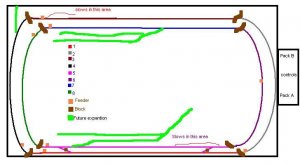He's talkin' bout a thin layer of slime you might not even be able to see, jest 'nuff to block off that electro-magic half way. You should take a clean white rag and put some goo gone on it it and rub down the track real good. Adding goo gone and turnin' the rag as you go. See all that black yucky stuff? Now you should read Shamus's track cleanin' tips down at the bottom, in the archives, the academy

It's likely your problem.
If not, it could be the connections between the tracks, like you already hinted at, wantin' to solder them. Well you can solder them if you like, there's differing opinions on that, but you will have to clean them up real good for the solder to take. Sometimes you can take it apart, gently tighten the joiners with plyers and reassemble, but best to have a spare joiner or two on hand.
It could also be voltage drop across the track if it's real long. Unless you got that real expensive solid gold track, you get some drop of the voltage across the length. NS is worst than brass for this, but both do it. Copper is best, next to gold that is, and you can run copper to both ends of each block to minimise this effect. Also take a shortcut, straight from the transformer to each end, and not from transformer to one end to the other end, use two seperate wires, joined together at the transformer (or block selection switch).
one the train slows down where the power is being fed to the block.
This seems to indicate the power is either not going that section, if you have more than on connection per block, or the connection is good, but the tracknear the pickup is dirty (it goes through the track to the other sections further away, but not to the loco throught the top of the track. Make Cents? $?





